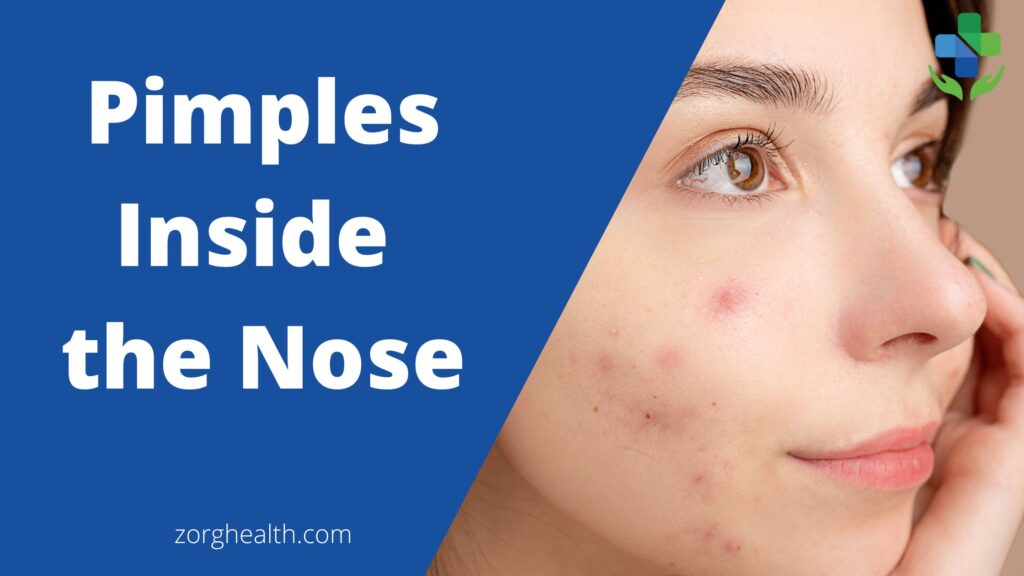Pimples, those bothersome bumps that often appear on our skin, can also manifest inside the nose, causing discomfort and irritation. Understanding what pimples are, why they form, and the reasons behind their occurrence inside the nose can help shed light on this common issue.

Pimples, medically referred to as acne, are small eruptions that occur when the pores in our skin become clogged. These pores are connected to oil glands, which produce sebum, an oily substance that helps keep our skin moisturized. When excess sebum, dead skin cells, or bacteria accumulate within the pores, it can lead to blockages, resulting in the formation of pimples.
Learn about Pimples Inside the Nose – TOC
Symptoms of pimples inside the nose
The presence of pimples inside the nose can cause several symptoms. Here are some common symptoms you may experience:
- Pain: Pimples inside the nose can be painful, ranging from mild discomfort to more severe soreness or tenderness. The pain may worsen when pressure is applied or when you touch or manipulate the affected area.
- Swelling: Pimples inside the nose can cause localized swelling. The surrounding skin may appear puffy or inflamed due to the body’s immune response to the pimple.
- Redness: The affected area may become red or flushed. This is a result of increased blood flow and inflammation caused by the pimple.
- Tenderness: Pimples inside the nose can be sensitive to touch. Even light pressure or movement of the nasal tissues can cause discomfort or pain.
- Formation of a bump or lump: Pimples typically manifest as small raised bumps or lumps within the nasal passage. You may be able to feel or see the bump when looking inside the nostril.
- Presence of pus or discharge: In some cases, pimples inside the nose may contain pus or have a discharge. This can be a sign of an infection and may be accompanied by increased pain and swelling.
- Difficulty breathing or nasal congestion: Depending on the size and location of the pimple, it can partially block the nasal passage, leading to temporary nasal congestion or difficulty breathing through the affected nostril.
It’s important to note that these symptoms can vary from person to person, and the severity may differ as well.
What causes them to appear inside the nose?
Pimples inside the nose can be caused by various factors. Here are some common reasons why they may appear:
- Bacterial or Fungal Infections: The nose contains a diverse range of bacteria and fungi. When these microorganisms enter the pores or hair follicles inside the nose, they can cause an infection. This leads to inflammation, redness, and the formation of pimples.
- Hormonal Changes: Hormonal fluctuations, such as those experienced during puberty, menstruation, or pregnancy, can trigger an increase in sebum production. Excess sebum can clog the pores inside the nose and contribute to the formation of pimples.
- Nose Picking: Engaging in the habit of picking your nose can introduce dirt, bacteria, and other irritants into the nasal passages. This can lead to pore blockages and the development of pimples.
- Allergies and Irritants: Exposure to allergens or irritants, such as dust, pollen, or certain chemicals, can cause an inflammatory response in the nose. This inflammation can disrupt the normal functioning of the sebaceous glands and contribute to the occurrence of pimples.
- Nasal Trauma: Physical trauma to the nose, such as a blow or injury, can cause inflammation and disrupt the skin’s natural balance. This can create an environment conducive to pimple formation.
- Poor Hygiene: Inadequate nasal hygiene, such as infrequent washing or improper cleaning, can lead to the accumulation of dirt, oil, and bacteria inside the nose. This can increase the likelihood of developing pimples.
It’s important to note that the exact cause of pimples inside the nose can vary from person to person. Additionally, individual factors like genetics, lifestyle, and overall health can influence their occurrence. Understanding the underlying causes can help individuals take preventive measures and seek appropriate treatment to manage pimples inside the nose effectively.
Treatment/Home Remedies for Pimples inside the nose
While it’s important to consult with a skin doctor for proper diagnosis and treatment, here are some home remedies that may help alleviate the symptoms of pimples inside the nose:
- Warm Compress: Applying a warm compress to the affected area can help reduce pain and swelling. Dip a clean washcloth in warm water, wring out the excess moisture, and gently press it against the pimple inside your nose for 5-10 minutes. Repeat this several times a day.
- Saline Solution: Rinsing your nose with a saline solution can help keep the area clean and reduce inflammation. Mix 1/2 teaspoon of salt in a cup of warm water until it dissolves. Using a clean dropper or nasal irrigation bottle, gently flush the saline solution into each nostril. This can be done a few times a day.
- Tea Tree Oil: Known for its antimicrobial properties, tea tree oil can help fight bacteria and reduce inflammation. Mix a few drops of tea tree oil with a carrier oil like coconut or olive oil. Apply a small amount to the pimple using a cotton swab. Leave it on for a few hours or overnight before rinsing off with warm water. Use caution, as tea tree oil may cause skin irritation in some individuals. Discontinue use if any adverse reactions occur.
- Aloe Vera Gel: Aloe vera has soothing and anti-inflammatory properties that may help reduce pain and inflammation. Apply a small amount of pure aloe vera gel directly to the pimple inside your nose. Leave it on for 15-20 minutes, then rinse off with lukewarm water. Repeat this a few times a day.
- Garlic: Garlic has natural antibacterial properties. Crush a garlic clove and mix it with a small amount of water to form a paste. Apply the paste to the pimple and leave it on for 10-15 minutes before rinsing off with water. Repeat once or twice a day. Be cautious, as garlic may cause skin irritation in some individuals. Avoid using this remedy if you have sensitive skin.
Remember, these home remedies may provide temporary relief, but they are not a substitute for professional medical advice. If your symptoms persist or worsen, it’s best to consult a healthcare professional for proper evaluation and treatment.
Complications & When to Seek Doctor
If left untreated, pimples inside the nose can lead to potential complications. These may include the spread of infection to other areas, such as the sinuses or the skin surrounding the nose. In some cases, the pimples can become larger and more painful, forming abscesses that require medical attention. Additionally, squeezing or popping the pimples can increase the risk of scarring and further infection.
It’s important to know when to seek medical help for pimples inside the nose. If the pimples do not improve with home remedies or over-the-counter treatments, or if they are accompanied by severe pain, excessive swelling, or other concerning symptoms, it is recommended to see a doctor. They can evaluate the condition, provide appropriate treatment, and rule out any underlying health issues.
The Bottom Line
Pimples inside the nose can be uncomfortable and bothersome. By understanding the causes, symptoms, and treatment options, you can take steps to alleviate the discomfort and prevent further occurrences. Remember to practice good hygiene, avoid nose-picking, and seek medical advice if needed.
